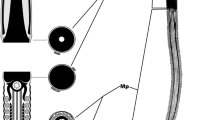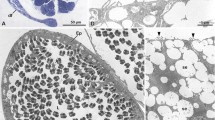Abstract
Early spermatids of the dendrobranchiate shrimp Parapenaeus longirostris (Lucas, 1846) have a spherical nucleus with large patches of heterochromatin, surrounded by a cytoplasmic mass that contains the conspicuous proacrosomal vesicle. The highly polarized mid spermatid mainly consists of the nuclear region, displaying a discontinuous nuclear envelope, and a large proacrosomal vesicle located at the opposite side of the cell. The most recent spermiogenic transformations primarily concern elongation of the proacrosomal vesicle to form a tapering spike. This results in the typically tack-shaped sperm of natantian decapods. The initial steps of spermiogenesis in the two studied dendrobranchiates prove to be parallel to reptant spermiogenesis in some respects, namely rupture of the nuclear envelope, chromatin decondensation and differentiation of electron-dense regions within the proacrosomal vesicle content. Specifically, whereas the anteriormost condensation gives rise to the operculum in brachyurans, in dendrobranchiates it becomes the apical portion of the spike. Despite an unquestionable morphological similarity between the sperm of carideans and dendrobranchiates, spermiogenesis in both groups displays meaningful differences. Spermatids of caridean shrimps lack a distinct proacrosomal vesicle. In the course of spermiogenesis, the spike arises from aggregated cytosolic materials; hence it is not membrane-bound. Unlike in other decapods, caridean sperm do not undergo a conventional acrosome reaction, since exocytotic events are not involved in this process. The above arguments suggest that, in the Decapoda, separation into three sperm classes is more suitable than the two traditionally accepted classes. The dendrobranchiate and reptant sperm types share a number of spermiogenic and functional features, while the caridean sperm type appears to represent an independent evolutive line with regard to sperm development and function.
Similar content being viewed by others
References
Anderson WA, Ellis RA (1967) Cytodifferentiation of the crayfish spermatozoon: acrosome formation, transformation of mitochondria and development of microtubules. Z Zellforsch 77: 80–94
Arsenault AL (1984) Changes in the nuclear envelope associated with spermatid differentiation in the shrimp, Crangon septemspinosa. J Ultrastruct Res 8:294–308
Arsenault AL, Clattenburg RE, Odense PH (1979) Spermiogenesis in the shrimp, Crangon septemspinosa, Say. Can J Zool 57: 486–498
Arsenault AL, Clattenburg RE, Odense PH (1980) Further observations on spermiogenesis in the shrimp, Crangon septemspinosa. A mechanism for cytoplasmic reduction. Can J Zool 58:497–506
Barros C, Dupré E, Viveros L (1986) Sperm-egg interaction in the shrimp Rhynchocinetes typus. Gamete Res 14:171–180
Binford R (1913) The germ cells and the process of fertilization in the crab, Menippe mercenaria. J Morph 24:147–202
Brown A Jr, Talbot P, Summers RG, Clark WH Jr (1977) Comparative analysis of decapod sperm. J Cell Biol 75: p. 170 A
Brown GG (1966) Ultrastructural studies of sperm morphology and sperm-egg interaction in the decapod Callinectes sapidus. J Ultrastruct Res 14:425–440
Burkenroad MD (1981) The higher taxonomy and evolution of Decapoda (Crustacea). Trans S Diego Soc nat Hist 19:251–268
Chevaillier P, Maillet PL (1965) Structure fine et constitution cytochimique du spermatozoïde de la langoustine Nephrops norvegicus L. (crustacé décapode). J Microscopie 4:679–700
Chow S, Dougherty WJ, Sandifer PA (1991) Unusual testicular lobe system in the white shrimps, Penaeus setiferus (Linnaeus, 1761) and P. vannamei Boone, 1931 (Decapoda, Penaeidae); a new character for Dendrobranchiata? Crustaceana 60:304–318
Clark WH Jr, Griffin FJ (1988) The morphology and physiology of the acrosome reaction in the sperm of the decapod, Sicyonia ingentis. Dev Growth Differentiation 30:451–462
Clark WH Jr, Kleve MG, Yudin AI (1981) An acrosome reaction in natantian sperm. J exp Zool 218:279–291
Clark WH Jr, Talbot P, Neal RA, Mock CR, Salser BR (1973) In vitro fertilization with non-motile spermatozoa of the brown shrimp Penaeus aztecus. Mar Biol 22:353–354
Clark WH Jr, Yudin AI, Griffin FJ, Shigekawa K (1984) The control of gamete activation and fertilization in the marine Penaeidae, Sicyonia ingentis. In: Engles W, Clark WH Jr, Fischer A, Olive PJW, Went DF (eds) Advances in invertebrate reproduction. Vol 3. Elsevier Science Publishers, Amsterdam, pp 459–472
Demestre M, Cortadellas N, Dufort M (1993) Ultrastructure de les espermatides de la gamba, Aristeus antennatus (crustaci, Decapoda). [In Catalan] Biologia Reprod 3:14–17
Demestre M, Fortuño J-M (1992) Reproduction of the deep-water shrimp Aristeus antennatus (Decapoda, Dendrobranchiata). Mar Ecol Prog Ser 84:41–51
Dougherty WJ, Dougherty MM (1989) Electron microscopical and histochemical observations on melanized sperm and spermatophores of pond-cultured shrimp, Penaeus vannamei. J Invert Path 54:331–343
Dudenhausen EE, Talbot P (1982) An ultrastructural analysis of mature sperm from the crayfish Pacifastacus leniusculus, Dana. Int J Invert Reprod 5:149–159
Dupré E, Barros C (1983) Fine structure of the mature spermatozoon of Rhynchocinetes typus, Crustacea Decapoda. Gamete Res 7: 1–18
Felgenhauer BE, Abele LG (1991) Morphological diversity of decapod spermatozoa. In: Bauer RT, Martin JW (eds) Crustacean sexual biology. Columbia University Press, pp 322–341
Felgenhauer BL, Abele LG, Kim W (1988) reproductive morphology of the anchialine shrimp Procaris ascensionis (Decapoda: Procarididae). J Crustacean Biol 8:333–339
Goudeau M (1982) Fertilization in a crab. I. Early events in the ovary, and cytological aspects of the acrosome reaction and gamete contacts. Tissue Cell 14:97–111
Griffin FJ, Clark WH Jr (1990) Induction of acrosomal filament formation in the sperm of Sicyonia ingentis. J exp Zool 254:296–304
Griffin FJ, Shigekawa K, Clark WH Jr (1988) Pormation and structure of the acrosomal filament in the sperm of Sicyonia ingentis. J exp Zool 246:94–102
Haley SR (1986) Ultrastructure of spermatogenesis in the Hawaiian red lobster, Enoplometopus occidentalis (Randall). J Morph 190: 81–92
Hinsch GW (1969) Microtubules in the sperm of the spider crab, Libinia emarginata L. J Ultrastruct Res 29:525–534
Hinsch GW (1971) Penetration of the oocyte envelope by spermatozoa in the spider crab. J Ultrastruct Res 35:86–97
Hinsch GW (1973) Sperm structure of Oxyrhyncha. Can J Zool 51: 421–426
Hinsch GW (1980) Spermiogenesis in Coenobita clypeatus. I. Sperm structure. Int J Invert Reprod 2:189–198
Hinsch GW (1986) A comparison of sperm morphologies, transfer and sperm mass storage between two species of crab, Ovalipes ocellatus and Libinia emarginata. Int J Invert Reprod Dev 10: 79–87
Hinsch GW (1988) Ultrastructure of the sperm and spermatophores of the golden crab Geryon fenneri and a closely related species, the red crab G. quinquedens, from the eastern Gulf of Mexico. J Crustacean Biol 8:340–345
Hinsch GW (1991) Ultrastructure of the sperm and spermatophores of the anomuran crab Pleuroncodes planipes. J Crustacean Biol 11:17–22
Jamieson BGM (1987) The ultrastructure and phylogeny of insect spermatozoa. Cambridge University Press, Cambridge
Jamieson BGM (1989a) Ultrastructural comparison of the spermatozoa of Ranina ranina (Oxystomata) and of other crabs exemplified by Portunus pelagicus (Brachygnatha) (Crustacea, Brachyura). Zoomorphology 109:103–111
Jamieson BGM (1989b) The ultrastructure of the spermatozoa of four species of xanthid crabs (Crustacea, Brachyura, Xanthidae). J submicrosc Cytol Path 21:579–584
Jamieson BGM (1990) The ultrastructure of the spermatozoa of Petalomera lateralis (Gray) (Crustacea, Brachyura, Dromiacea) and its phylogenetic significance. Int J Invert Reprod Dev 17:39–45
Jamieson BGM (1991a) Fish evolution and systematics: evidence from spermatozoa. Cambridge University Press, Cambridge
Jamieson BGM (1991b) Ultrastructure and phylogeny of crustacean spermatozoa. Mem Qd Mus 31:109–142
Jamieson BGM, Tudge CC (1990) Dorippids are Heterotremata: evidence from ultrastructure of the spermatozoa of Neodorippe astuta (Dorippidae) and Portunus pelagicus (Portunidae) Brachyura: Decapoda. Mar Biol 106:347–354
Kaye GI, Pappas GD, Yasuzumi G, Yamamoto H (1961) The distribution and form of the endoplasmic reticulum during spermatogenesis in the crayfish, Cambaroides japonicus. Z Zellforsch 53: 159–171
Kim W, Abele LG (1990) Molecular phylogeny of selected decapod crustaceans based on 18S rRNA nucleotide sequences. J Crustacean Biol 10:1–13
Kleve MG, Yudin AI, Clark WH Jr (1980) Fine structure of the unistellate sperm of the shrimp, Sicyonia ingentis (Natantia). Tissue Cell 12:29–45
Koehler LD (1979) A unique case of cytodifferentiation: spermiogenesis of the prawn, Palaemonetes paludosus. J Ultrastruct Res 69:109–120
Langreth SG (1965) Ultrastructural observations on the sperm of the crab Cancer borealis. J Cell Biol 27: p. 56 A
Langreth SG (1969) Spermiogenesis in Cancer crabs. J Cell Biol 43: 575–603
López-Camps J, Bargalló R, Bozzo MG, Durfort M, Fontarnau R (1981) The spermatogenesis of crustaceans. VII. Review of spermatozoon of the crayfish Astacus astacus (Malacostraca, Decapoda, Macrura, Reptantia). Gamete Res 4:65–82
Lynn JW, Clark WH Jr (1983a) A morphological examination of sperm—egg interaction in the freshwater prawn, Macrobrachium rosenbergii. Biol Bull mar biol Lab, Woods Hole 164:446–458
Lynn JW, Clark WH Jr (1983b) The fine structure of the mature sperm of the freshwater prawn, Macrobrachium rosenbergii. Biol Bull mar biol Lab, Woods Hole 164:459–470
McKnight CE, Hinsch GW (1986) Sperm maturation and ultrastructure in Scyllarus chacei. Tissue Cell 18:257–266
Medina A (1992) Structural modifications of sperm from the fiddler crab Uca tangeri (Decapoda) during early stages of fertilization. J Crustacean Biol 12:610–614
Medina A, Rodríguez A (1992a) Spermiogenesis and sperm structure in the crab Uca tangeri (Crustacea, Brachyura), with special reference to the acrosome differentiation. Zoomorphology 111: 161–165
Medina A, Rodríguez A (1992b) Structural changes in sperm from the fiddler crab, Uca tangeri (Crustacea, Brachyura), during the acrosome reaction. Molec Reprod Dev 33:195–201
Moses MJ (1960) A light and electron microscopy study of spermiogenesis in decapod Crustacea. Anat Rec 136: p 342
Moses MJ (1961) Spermiogenesis in the crayfish (Procambarus clarkii). II. Description of stages. J biophys biochem Cytol 10:301–333
Ogawa Y, Kakuda S (1987) Scanning electron microscopic observations on the spermatozoa of the prawn Penaeus japonicus. Nippon Suisan Gakk 53:975–977
Papathanassiou E, King PE (1984) Ultrastructural studies on gametogenesis of the prawn Palaemon serratus (Pennant). II. Spermiogenesis. Acta Zool, Stockh 65:33–40
Pearson PJ, Walker MH (1975) Alteration of cytochrome C oxidase activity during spermatogenesis in Carcinus maenas. Cell Tissue Res 164:401–410
Pérez C, Roco A, Castro A, Dupré E, Schatten G, Barros C (1991) Localization of microfilaments and a tubulin-like protein in crustacean (Rhynchocinetes typus) spermatozoon. Molec Reprod Dev 28:373–379
Pochon-Masson J (1965) Schéma du spermatozoïde dévaginé. de Homarus vulgaris (décapode macroure). Cr hebd Séanc Acad Sci, Paris 260:5352–5354
Pochon-Masson J (1968a) L'ultrastructure des spermatozoïdes vésiculaires chez les crustacés décapodes avant et au course de leur dévagination expérimentale. I. Brachyoures et Anomoures. Annls Sci nat (sér Zool) 10:1–100
Pochon-Masson J (1968b). L'ultrastructure des spermatozoïdes vésiculaires chez les crustacés décapodes avant et au cours de leur dévagination expérimentale. II. Macroures. Discussion et conclusions. Annls Sci nat (sér Zool) 10:367–454
Pochon-Masson J (1969) Infrastructure du spermatozoïde de Palaemon elegans (De Man) (crustacé décapode). Archs Zool exp gén 110:363–372
Reger JF (1970) Studies on the fine structure of spermatids and spermatozoa of the crab Pinnixia sp. J Morph 132:89–100
Shigekawa K, Clark WH Jr (1986) Spermiogenesis in the marine shrimp, Sicyonia ingentis. Dev Growth Differentiation 28:5–112
Spurr AR (1969) A low viscosity epoxy-resin embedding medium for electron microscopy. J Ultrastruct Res 26:31–43
Talbot P, Chanmanon P (1980a) The structure of sperm from the lobster, Homarus americanus. J Ultrastruct Res 70:275–286
Talbot P, Chanmanon P (1980b) Morphological features of the acrosome reaction of lobster (Homarus) sperm and the role of the reaction in generating forward sperm movements. J Ultrastruct Res 70:287–297
Talbot P, Poolsanguan B, Al-Hajj H, Poolsanguan W (1991) Gamete interactions during in vitro fertilization of lobster (Homarus americanus) oocytes. J struct Biol 106:125–134
Talbot P, Summers RG (1978) The structure of sperm from Panulirus, the spiny lobster, with special regard to the acrosome. J Ultrastruct Res 64:341–351
Tudge CC (1992) Comparative ultrastructure of hermit crab spermatozoa (Decapoda: Anomura: Paguroidea). J Crustacean Biol 12:397–409
Tudge CC, Jamieson BGM (1991) Ultrastructure of the mature spermatozoon of the coconut crab Birgus latro (Coenobitidae: Paguroidea: Decapoda). Mar Biol 108:395–402
Yasuzumi G (1960) Spermatogenesis in animals as revealed by electron microscopy. VII. Spermatid differentiation in the crab, Eriocheir japonicus. J biophys biochem Cytol 7:73–77
Yudin AI, Clark WH Jr, Kleve MG (1979) An acrosome reaction in natantian sperm. J exp Zool 210:569–574
Author information
Authors and Affiliations
Additional information
Communicated by S. M. Pérès, Marseille
Rights and permissions
About this article
Cite this article
Medina, A. Spermiogenesis and sperm structure in the shrimp Parapenaeus longirostris (Crustacea: Dendrobranchiata): comparative aspects among decapods. Marine Bioliogy 119, 449–460 (1994). https://doi.org/10.1007/BF00347542
Received:
Accepted:
Issue Date:
DOI: https://doi.org/10.1007/BF00347542




